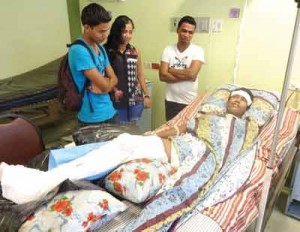Health Ministry out of anti-venom
Procurement to be given same priority as ARVs – Health Minister
By Mondale Smith, September 14, 2015 | By KNews | Filed Under News, Source
Persons who work in the mining and timber sectors or live in the hinterland are being advised to be smart and use long boots or protective gear as they are in the habitat of venomous animals, especially snakes.
This advice comes from Minister of Health, Dr. George Norton who disclosed that Guyana’s health institutions have no anti-venom in stock to treat victims bitten by venomous snakes. The Minister admits that, “this has been the reality for several years.”
But while there have been reported successful ‘traditional’ ways of treating persons bitten by venomous snakes, the local health institutions uses antibiotics and can only administer symptomatic antidotes.
This is the reality even as the nation’s hinterlands are home to many species of venomous snakes which have dealt lethal bites to some persons.
Based on statistics, a number of the persons bitten have died at the Georgetown Hospital because they were brought out of the hinterland or to the institution too late, according to the Health Minister.
However, Minister Norton said that all things being equal, that state may soon change for the better.
The issue of Guyana not having any anti-venom dates back several years to when Dr. Norton served as shadow Health Minister in the opposition benches.
He promised that efforts will be made to rectify the situation in the shortest possible time but could not say exactly when. “I have it as a priority to get anti-venom to all the hospitals soon.”
The Minister said that this procurement will be among the Health Ministry’s top priorities. “Once we start the bidding in the same way that we treat the anti-retrovirals, we will make sure that we have ample supply of the anti-venom.”
The open tendering policy for medical supplies has seen many expressing interest from the Caribbean and Africa to supply Guyana with anti-venom for several years.
According to medical professionals and solidified by Dr. Norton, “despite of one’s location, the chance of survival after a venomous bite, especially from a Labaria or Bushmaster is slim, even if there is anti-venom available.
And that chance moves from slim to none if there is no anti-venom available.
“We hope that we will get those persons to compete in an open bid so that we can have the anti-venom situation solved, particularly to be distributed in regions where we have incidences of snake bites. But regardless, we must have it at the Georgetown hospital.”
In the meantime, Guyana has been subscribing to the use of antibiotics for symptomatic treatment of patents as is the case of Kevin Gomes, 17, of the North West District, whose fate hangs in the balance as a victim of a Labaria snake’s venomous bite.
He is hoping that he will not lose his right leg while he is being administered symptomatic treatment by medical professionals. His leg which was covered with blisters and turning black is now strapped and he has a temperature in addition to some swelling about his body.
In his case, the Minister said that the hospital is doing all it can and is optimistic that he will come around. However, according to the Minister, “He is one of many worrying cases who have been bitten that we are not proud of and we will do everything in our power to correct this situation this year, hopefully.”
As far as the Health Minister’s research and consultation with suppliers go, anti-venom is not too hard to come by but he could not say what prevents the life saving medicine from being in the Ministry’s medical supplies stock.
Local general practitioners’ current method of treating persons bitten by venomous snakes in the Hinterland is to administer saline and antibiotics based on their symptoms.
However, based on findings many victims are faced with the problem of excess bleeding and medical professionals treating them often have to offer medication to minimize the bleeding once taken to health institutions. But the rule is that they be evacuated soonest to the Georgetown Hospital.
At present there is another report of another victim being medi-vacced to the capital city for treatment.
In 2009, Maxey Edmund, 27, of Philippi Village, Region Seven lost his life after being bitten on his left calf by a poisonous snake.
The stricken man had walked some 40 miles for treatment, from his village all the way to the Annai Health Centre. By the time he reached, his condition had deteriorated, forcing the Health Centre to transport him for additional treatment in Georgetown, where he was admitted to the Intensive Care Unit (ICU).
In 2012, Nelson Daniels, a 45-year-old labourer, of Warapana, Upper Pomeroon River, succumbed to the poison of a Labaria snake four days after he was bitten.
The father of four was reportedly unable to access medical attention in time due to financial constraints, coupled with the remoteness of the area in which he lived.
He was transported to the Oscar Joseph Hospital at Charity and then to the GPHC after his condition worsened.


